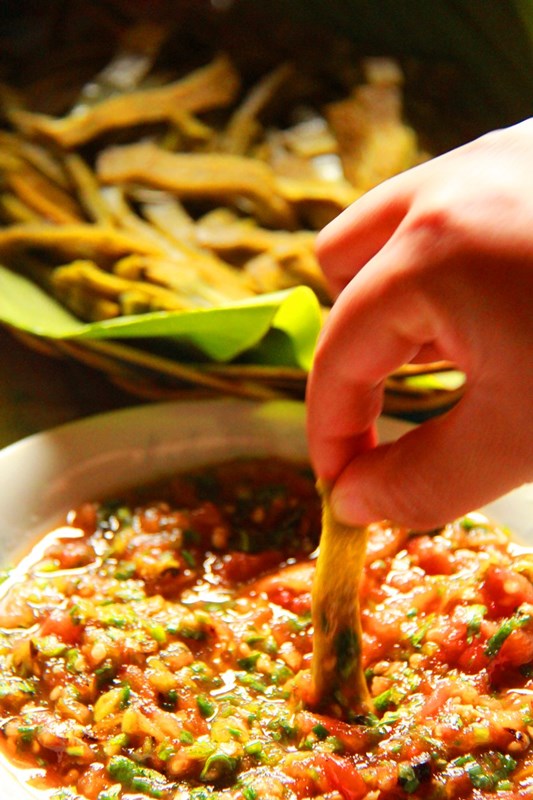
Yu Die is a reputed chef in Manta Dai village, Jiangcheng Hani and Dai autonomous county in Pu’er city, southwestern Yunnan province.
Her house, for long, has been a popular dinning place for people living nearby, specially on festival days. This time, she decides to prepare a number of Dai dishes to welcome us upon our arrival, including Dai-style lime chicken, deep-fried cow skin as well as sapie (a cold dish comprising bovine bile). 
However, what has fascinated us the most are those bowls of spicy and sour dipping sauces placed on table, called nanmi. Having sour bamboo shoots, peanuts or tamarillos in them, these classic sauces help add a completely new layer of flavor to plates.
The Dai ethnic minority people dwelling in south and southwest Yunnan has a long tradition of eating raw food, particularly vegetables such as cucumber, cabbage, lettuce and fennel. 
Yet their tastes - in the eyes of local residents - would be highly compromised without the presence of nanmi, a home-made dipping sauce which normally consists of garlic, lime juice, red chilli peppers, tamarillos and some more ingredients. It is not exaggerated to say that nanmi is the key to many Dai recipes. A typical Dai banquet comprises several dishes and each of them has a nanmi being placed aside to be eaten with. To some extent, the number of nanmi on table indicates the importance as well deliciousness of a meal. Nevertheless, as a tasty bowl of nanmi often entails multiple ingredients and a few steps of preparation, it is not easy to be done anyway. 

The Dai-style Nanmi is usually made with tomatoes, peanuts, sour bamboo shoots, green vegetables or even fish. A wide range of cooking techniques can be seen involving in its preparation, including roasting, grilling, pestling, chopping as well as mixing. According to Yu Die, nanmi can be made into different tastes, such as salty, sour, spicy, numb, sweet and bitter. The bamboo shoot nanmi and tamarillo nanmi she prepares for us, for instance, are dominated by sourness and spiciness. 
Apart from the consumption of raw food, another hallmark which differentiates Dai people’s eating habit from some other ethnic minority groups is the affection for sour and spicy flavors. And this, of course, has to do with the sweltering tropical and subtropical climates in south and southwest Yunnan. Local residents believe that sour and spicy dishes are not only ideal appetizers for sizzling summer days; they can help ward off colds as well. Bamboo shoot nanmi is made by picked bamboo shoots having been soaked in saline water for 10 days. Chopped bamboo shoots then need to mixed up with smashed garlic, red chili powder, cilantro and salt before serving. And to prepare tamarillo nanmi, one has to toast tamarrillos on fire and remove their skins before they can join the dipping made of fresh red chili peppers and cilantro. We may not know how other people feel about nanmi, but to the Dai residents, it is undoubtedly off-the-scale delicious Writing by Zhang Lin; trans-editing by Wang Jingzhong; photographs by Liu Jiatong |











7740f3b5-9ecb-438e-9052-76cb2d4bb671.jpg)

